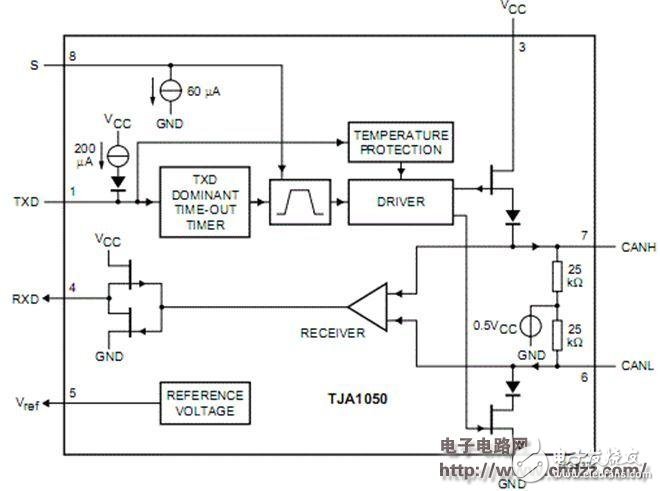CAN network impedance
The beginning of the problem is started by the CAN network. The following figure is a basic model of a CAN network with 120 ohm resistors at both ends.
The characteristic impedance of the wire used in the can network is also 120 ohms. There are several problems that are split separately to illustrate.

1. Why use 120 ohm terminal impedance?
First, the transmission line is used in the CAN network. The characteristic impedance of the wire is 120 ohms. Let ’s talk about the following problems with the line. In addition, the device in the CAN network, that is, the CAN transceiver, has a low output impedance and a high input impedance. You can see the block diagram of the TJA1050. That is to say, the signal transmitted by the characteristic impedance of 120 ohms on the transmission line suddenly reaches a place with a high impedance, which can be understood as an open circuit. This will cause a high signal reflection, which will affect the CAN transceiver's level sampling and cause information errors. read. If a 120 ohm resistor or termination resistor is added between CANH and CANL, because this resistance is the same as the characteristic impedance of the cable, and this resistance, which is much smaller than the output impedance of the CAN transceiver, is paralleled with the CAN transceiver, the current is naturally more Most of them flow from places where the impedance is small, so that from the resistance of 120 ohms on the flow path of the 120 ohm cable with a characteristic impedance, the impedance between them is close, and their signal reflection is much smaller, which can effectively ensure signal integrity. At the same time, this resistance will not affect the signal itself as shown below. For example, in a fault-tolerant CAN network, CANH = 3.5v, CANL = 0.5v is dominant, CANH = CANL = 2.5v is invisible, in the dominant position When the terminal resistance is 3.5v and 1.5v respectively, one CAN transceiver is the output and one CAN transceiver is the receiver. The output is at the output voltage, keeping the voltage of CANH and CANL at 3.5v and 1.5v. The voltage difference between them will cause current to be consumed by the terminal resistance. The CANH and CANL at the receiving end can accurately sample the voltage values ​​of 3.5v and 1.5v. Similarly, the terminal resistance does not affect the signal of the CAN network during the invisible position. But the effect of impedance matching is achieved.


2. How to define the characteristic impedance of the wire with 120 ohm characteristic impedance wire used by CAN network?
Characteristic impedance is a specific characteristic of a material that we are talking about here, due to its thickness, size and other factors. The characteristic impedance of a wire or coaxial cable does not change with the length and the frequency of the transmitted signal (the frequency will be different, but it is very small, theoretically it does not change with frequency), and the characteristic impedance also has its own Reflecting the conditions, in the DC state, if you use a multimeter to measure the impedance of a section of wire, the result should be Z = 0 ohms. But the marked characteristic impedance of this wire is 50 ohms. The so-called 50-ohm characteristic impedance is reflected in the high-frequency signal transmission process. It is reflected by the following formula, see the figure below:

among them
R = resistivity per unit length of the conductor material (in the case of DC), ohm
G = bypass conductance per unit length (conductivity of insulating layer), ohm
j = just a symbol, indicating that this term has a phase angle of +90 '(imaginary number)
Ï€ = 3.1416
L = the inductance of the cable per unit length
c = capacity per unit length of cable
Under DC conditions, R and G in the formula can be ignored. The formula can be simplified to find the square root of L / C. If this wire is very short, L should be very close to 0, so the final value is also 0, if this line is very long, then L can not be ignored, you can also see that there is a certain resistance value when measured with a multimeter.
In the process of high-frequency signal transmission, R and G cannot be ignored, and in the rise and fall of the AC signal, the impedance of the wire is reflected by the inductance and capacitance of the wire.
Pigtail FC includes the single mode and multimode types.OFC pigtail are with premium grade connectors and with typical 0.9mm outer diameter cables. Pigtail FC is with different cable colors, cable diameters and jacket types optional. Pigtail FC Connector is compliant to IEC, TIA/EIA, NTT and JIS specifications. The FC connector is with PC, UPC, APC versions. Both single mode and multimode versions come with a zirconia ceramic ferrule.Pigtail FC are low back reflection and optical loss while ensuring maximum repeatability.It's applicable with 9/125 single mode, 50/125 multimode or 62.5/125 multimode fiber.
Pigtail FC
FC Pigtail,Pigtail FC,FC Pigtail Single Mode,FC Pigtail Multimode
Foclink Co., Ltd , https://www.scfiberpigtail.com